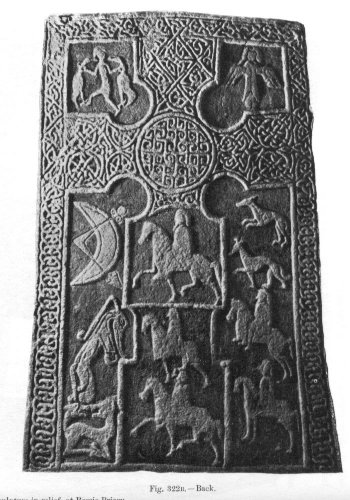It looks like you're using an Ad Blocker.
Please white-list or disable AboveTopSecret.com in your ad-blocking tool.
Thank you.
Some features of ATS will be disabled while you continue to use an ad-blocker.
share:
originally posted by: beansidhe
a reply to: Wifibrains
Our (lunar) crescent is always cut in 3 by the V-rod (or compasses, as I like to see them). Maybe the 3 phases of the moon? The Celts did like triplicate.
Remember that the moon phase, the moon simply being a mirror, are simply reflections of the earth/sun position. The waxing and waning crescents are simply made so by the earth blocking sunlight and so represent the profile of the earth. These crescent also mark the announcement of the new moon, no light in the depth of the underworld; the sun is under the earth (not literally), and then after with the reverse crescent to mark the beginning of the suns accent, resurrection. And its only by watching the moon that we see this picture of the solar drama as it where.
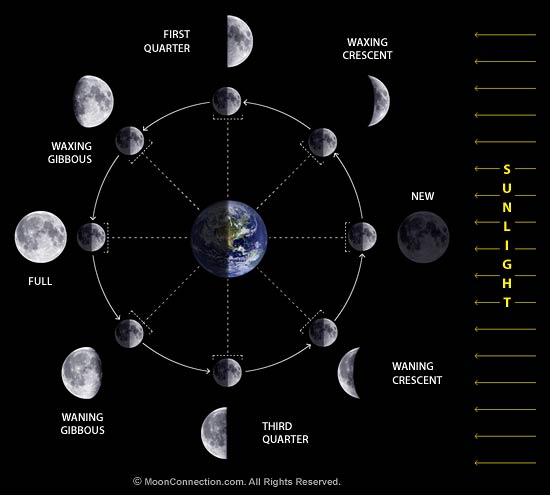
Moon Phases
The moon on the above Pict stone represents "the rise".
Stretched that out for a closer look. Might as well share it.


a reply to: Logarock
This is 1000's of years older than our Picts, but maybe worth a look again.
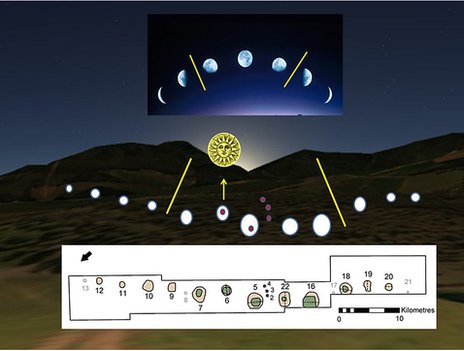
BBC Scotland's oldest calendar
It was the angle of the yellow sticks in the picture that got my attention.

This is 1000's of years older than our Picts, but maybe worth a look again.

BBC Scotland's oldest calendar
The Mesolithic "calendar" is thousands of years older than previous known formal time-measuring monuments created in Mesopotamia.
“
It is remarkable to think that our aerial survey may have helped to find the place where time itself was invented”
Dave Cowley
RCAHMS
The analysis has been published in the journal, Internet Archaeology.
The pit alignment also aligns on the Midwinter sunrise to provided the hunter-gatherers with an annual "astronomic correction" in order to better follow the passage of time and changing seasons.
Vince Gaffney, Professor of Landscape Archaeology at Birmingham, led the analysis project.
He said: "The evidence suggests that hunter-gatherer societies in Scotland had both the need and sophistication to track time across the years, to correct for seasonal drift of the lunar year and that this occurred nearly 5,000 years before the first formal calendars known in the Near East.
It was the angle of the yellow sticks in the picture that got my attention.

edit on 24-5-2014 by beansidhe because: sp
maybe, like today, there were people back than that drew crazy crap for their own artistic pleasure.
a reply to: jimmyx
There's too much antecedence from Babylonian, Hittite, Thracian, Dacian and Phoenician symbolism to dismiss the stones as art for art's sake. Also as they cover the whole of Scotland, across centuries, the persistence of the symbols is noticeable and meaningful. These symbols had meaning to people who were not yet thought to inhabit a nation - they were tribal, allegedly - and yet, we see clearly shared symbology across boundaries.
There's too much antecedence from Babylonian, Hittite, Thracian, Dacian and Phoenician symbolism to dismiss the stones as art for art's sake. Also as they cover the whole of Scotland, across centuries, the persistence of the symbols is noticeable and meaningful. These symbols had meaning to people who were not yet thought to inhabit a nation - they were tribal, allegedly - and yet, we see clearly shared symbology across boundaries.
Equinox!
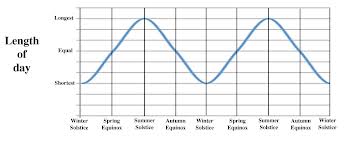
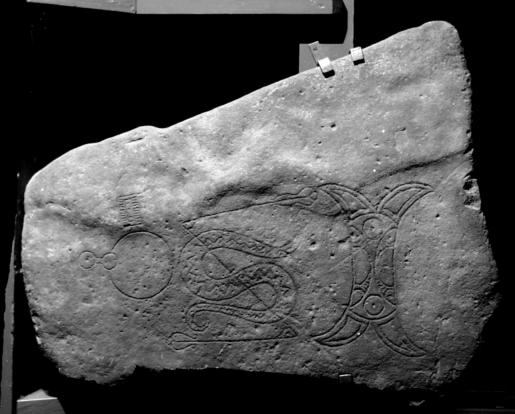
The above graph is for the southern hemisphere, so reverse it for all of us, and we should see the same pattern as the snake.
This is exciting - the snake then can be seen as the sun's progression through the equinoxes. The Z, I think, shows the pattern of death and rebirth, a story that lives on in the Cailleach and Bride, Ostara (Easter) etc.
A Z through two (sun) discs shows the 'birth' and 'death' of the sun each year, reminding us that as death follows life, so life will follow death.
The Coligny Calendar from 2nd AD proves that dates were known, followed and transcribed amongst the Celts.


The above graph is for the southern hemisphere, so reverse it for all of us, and we should see the same pattern as the snake.
This is exciting - the snake then can be seen as the sun's progression through the equinoxes. The Z, I think, shows the pattern of death and rebirth, a story that lives on in the Cailleach and Bride, Ostara (Easter) etc.
A Z through two (sun) discs shows the 'birth' and 'death' of the sun each year, reminding us that as death follows life, so life will follow death.
The Coligny Calendar from 2nd AD proves that dates were known, followed and transcribed amongst the Celts.
a reply to: beansidhe
I was looking at the double crescent again this morning. And I remembered this episode of Everybody Loves Raymond
And knowing that the Labyrs is related to the Labyrinth which I see as the womb of the earth, the feminine, I think we've established that point. Then I think "hmm I wonder if the word Labrys is related to Labia?"
And it seems there is a connection:
Labyrinth, Labyrs, Labia
A little later on in the article:
So I do a little search on Labyrinth at Encyclopedia Mythicaand find a little blurb about Welchanos,
this piques my interest because I just wondered if there is a connection to the Welch. I didn't find any particularly. Not much known about him apparently, I'll search it and see what we get:
The Hidden One
The author of this blog goes on to say that Welchanos represents the underworld phase of the sun, like Amon or Hades mean "The Unseen" or "hidden one".
Now I'm gonna bring it all back home. I'm starting from the potential connection between Israel and the Celts et. al.,
In my Sig thread (sorry to keep plugging it) and "Cult of the Bronze Serpent" I attempt to make a connection between the mining/metalsmith communities of Egypt and Israel. Hathor is the central focus, as the tabernacle(labyrinth) of Israel is patterned after her in the Qodesh Stele. Associated with these miners are Ptah, the demiurge creator, who is aka Haephestus or Vulcan. Also Amun.
Abu Simbel Temple
Amon, Hippocampus, Spiral
I touch on Amun and Ammonites which are spiral shells (labyrinths) in Egypt to Israel also. Sorry I'm short on time, I'll try and clear this up later, but hopefully the idea gets across.
I was looking at the double crescent again this morning. And I remembered this episode of Everybody Loves Raymond
And knowing that the Labyrs is related to the Labyrinth which I see as the womb of the earth, the feminine, I think we've established that point. Then I think "hmm I wonder if the word Labrys is related to Labia?"
And it seems there is a connection:
Labyrinth, Labyrs, Labia
The etymology for both labyrinth and labrys is the Greek labyrinthos ‘a network of intricate passageways.’ Cameron suggests, “from this same root comes the word labia. The butterfly-symbol may represent [the] opened labia” (SA: 10). Adding to the butterfly-labia consideration, archaeologists Sir Arthur Evans “published a series of chrysalises, butterflies, and goddesses related to chrysalises or with butterfly wings. (RN: 53-71.) He interpreted the chrysalis as an emblem of new life after death”
A little later on in the article:
From the earliest spirals, meanders, labyrinths, and labryses starting with ancient rock and cave symbols and engravings are reminders of human’s “unceasing preoccupation with the spiral order and his [one’s] spiral development” (MS: 29). The spiral may also “be thought of as an elementary unicursal labyrinth as they have an indirect path leading to a hidden center (MLW: 18).”
The spiral [and meander], depicted in ancient tombs, implies a death and re-entry into the womb of the earth, necessary before the spirit can be reborn in the land of the dead. But death and rebirth also mean the continuous transformation and purification of the spirit throughout life; the alchemists use the word VITRIOL to stand for Visita interiora terrae rectificando invenies occultum lapidem. ‘Visit the interior of the earth; through purification thou wilt find the hidden stone.’ Such a descent into the underworld (the kingdom of Pluto) is the theme for most initiation rituals, and is comparable to the passage through the wilderness, or the ‘dark night of the soul’, which is experienced by mystics [and all soul seekers] on their path. The spiral furthermore nearly always symbolizes it. Those on the columns of the Treasury of Atreus (a relic which is still to be found in the volutes of the Ionic column) have a further correspondence; by passing between two spiral columns, the initiate becomes the central axis or pillar and consciousness and equilibrium, for he [and she] has thus passed between two opposite pillars of the Tree of Life, or between the coils of the serpents of the caduceus, and has thereby come into direct contact with the Source of Being (MS: 29-30).
So I do a little search on Labyrinth at Encyclopedia Mythicaand find a little blurb about Welchanos,
In Knossos two ivory figurines came to light from the Labyrinth, which are perhaps the representations of this god. There are also suppositions that Welchanos could have been depicted on some seals from Hagia Triada, from Knossos or from Cydonia. These seals are showing us the young god accompanied by lions (similarly to the Master of Animals) or as a young god standing on the double axes between a winged wild goat and a daemon.
this piques my interest because I just wondered if there is a connection to the Welch. I didn't find any particularly. Not much known about him apparently, I'll search it and see what we get:
The Hidden One
(Wélchanos), there's a common theme in all of this: a Pre-Greek Cretan god named *Welkʰan. This god is in turn surely related to Etruscan *Velχan which is already accepted by Etruscan specialists to be the unattested source of the Latin name Vulcānus, also of non-Indo-European origin.
The author of this blog goes on to say that Welchanos represents the underworld phase of the sun, like Amon or Hades mean "The Unseen" or "hidden one".
Now I'm gonna bring it all back home. I'm starting from the potential connection between Israel and the Celts et. al.,
In my Sig thread (sorry to keep plugging it) and "Cult of the Bronze Serpent" I attempt to make a connection between the mining/metalsmith communities of Egypt and Israel. Hathor is the central focus, as the tabernacle(labyrinth) of Israel is patterned after her in the Qodesh Stele. Associated with these miners are Ptah, the demiurge creator, who is aka Haephestus or Vulcan. Also Amun.
Abu Simbel Temple
The complex consists of two temples. The larger one is dedicated to Ra-Harakhty, Ptah and Amun, Egypt's three state deities of the time, and features four large statues of Ramesses II in the facade. The smaller temple is dedicated to the goddess Hathor, personified by Nefertari, Ramesses's most beloved of his many wives.[5]
It is believed that the axis of the temple was positioned by the ancient Egyptian architects in such a way that on October 22 and February 22, the rays of the sun would penetrate the sanctuary and illuminate the sculptures on the back wall, except for the statue of Ptah, the god connected with the Underworld, who always remained in the dark. People gather at Abu Simbel to witness this remarkable sight, on October 21 and February 21
Amon, Hippocampus, Spiral
The magical hippocampus is the serpent-god of the sea. It appears with the head and body of a horse and large fishlike sea serpent hindquarters. Hippius, a name of Neptune and the Hippocampus was Neptune’s favorite horse. Neptune (Latin: Neptūnus) was the Roman god of water and the sea in Roman mythology and religion, a brother of Jupiter and Pluto. He is the counterpart of the Greek and one of the ancient gods of Phoenicia under the name of Poseidon. Neptune or Poseidon, is often riding a hippocampus or has his chariot drawn by two of them and his babies are called tadfoals. Scylla, the sea monster or Jonah the Great Fish.
I touch on Amun and Ammonites which are spiral shells (labyrinths) in Egypt to Israel also. Sorry I'm short on time, I'll try and clear this up later, but hopefully the idea gets across.
a reply to: zardust
Interesting stuff Z, and of course Mae's Howe and Newgrange have, if not labyrinthine, certainly womb-like qualities. Interestingly Mae's Howe used to have a moat around it, which may have symbolised a womb-like place, neither truly this world or otherworld.
So, again spirals can be seen to symbolise this world/otherworld/rebirth types of ideas. It hadn't really occurred to me until now, but there is not a labyrinth on one single Pict stone. Given the ubiquitousness of labyrinths/mazes in Celtic art elsewhere we should really expect to see one on a stone but we don't. Are you thinking that the double crescent might fulfil the same meaning?
That's an interesting view. The double feminine, Bride and Cailleach, birth and death, virgin and crone etc etc.
Interesting stuff Z, and of course Mae's Howe and Newgrange have, if not labyrinthine, certainly womb-like qualities. Interestingly Mae's Howe used to have a moat around it, which may have symbolised a womb-like place, neither truly this world or otherworld.
So, again spirals can be seen to symbolise this world/otherworld/rebirth types of ideas. It hadn't really occurred to me until now, but there is not a labyrinth on one single Pict stone. Given the ubiquitousness of labyrinths/mazes in Celtic art elsewhere we should really expect to see one on a stone but we don't. Are you thinking that the double crescent might fulfil the same meaning?
That's an interesting view. The double feminine, Bride and Cailleach, birth and death, virgin and crone etc etc.
Still thinking about astrology, I went back to Babylon.
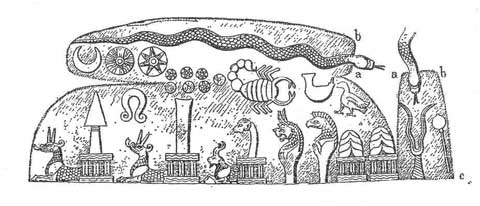
The above kudurru has a 'dog' with a bowed head in the centre, bottom row. Also it has a 2 pronged 'fork' at the far right.
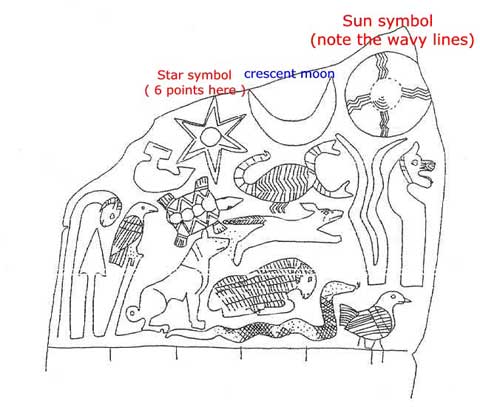
And again, far left 'bowed dog' and right, 2 pronged fork.
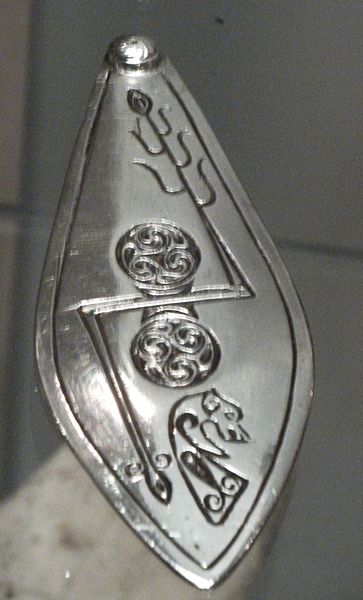
'Bowed dog'
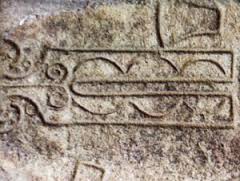
2 pronged fork.
Here the author explains some of the symbols:
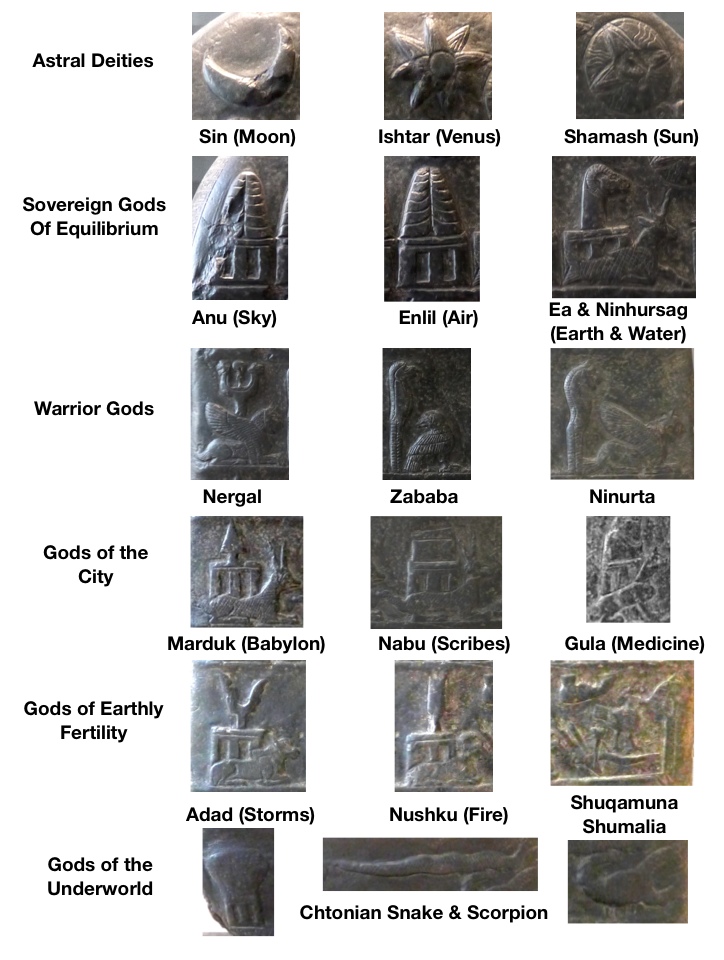
Source
The 2 pronged fork is the symbol of Adad, the God of storms. I wonder who his equivalent became?

The above kudurru has a 'dog' with a bowed head in the centre, bottom row. Also it has a 2 pronged 'fork' at the far right.

And again, far left 'bowed dog' and right, 2 pronged fork.

'Bowed dog'

2 pronged fork.
Here the author explains some of the symbols:

Source
The 2 pronged fork is the symbol of Adad, the God of storms. I wonder who his equivalent became?
edit on 27-5-2014 by beansidhe because: Added
link
He is Taranis.
Celtic NZ
Here he is, holding his symbols the wheel, thunderbolt and ...double disc?
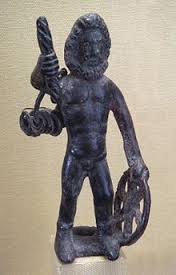
Again on the Gundestrup cauldron:

And incidentally, on the inside of the cauldron, our Pictish unicorn appears!
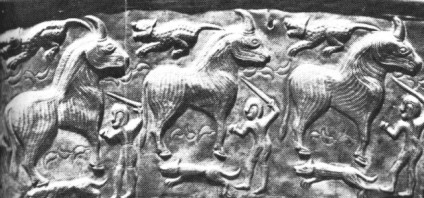
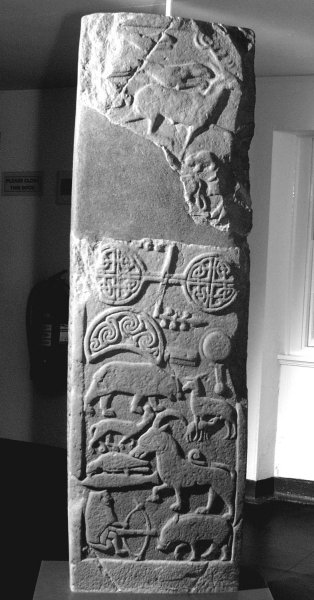
Taranis of ancient Gaul or Taranaich of ancient Scotland were one and the same as Thor of Scandinavia. These, in turn were developments of Jupiter of the Romans, which were derived from depictions and mythologies of Indra of Northern India (former homeland of the Aryans...European languages are largely Indo-Aryan). Britannia figurines of England depict the wheel of the Thunderer beside the seated Britannia.
The "Tara" nameplaces have survived in Ireland since remote antiquity and, presently, many Caucasoid mummies are being unearthed in the Tarin Basin north of Northern India in what is now a province of China. The Gaulish (French) name "Taranis" has an incredibly old pedigree extending back, it would seem, to the Tarin Basin and the "Thunderer" followed ancient Europeans in their travels all over the world in remote antiquity. Extending the migrations all the way to Britain, we have the "Tara" derived names leaving a trail behind them every step of the way.
In consideration of ancient Welsh/ Gaelic/ Breton/ Khumri variations on "Tara" we have the following:
"Taran" means "thunder" in Welsh/ Breton/ Khumri. The word "Tardd" would mean "breaking out".
"Tartar" means noise or clamour in Irish/ Gaelic.
Each of these descriptions in Welsh/ Khumri or Irish/ Gaelic migrated to Wales and Ireland via Scandinavia and Germany, where "Thor", meaning literally "thunder", was the preeminent Deity and created great thunder claps by crashing two rams heads together.
The Continental European Celts called their God, "Taranis" (the thunderer) and he bore that name in France and Spain amongst the Druids, as well as, seemingly, Celtic countries like Germany, Switzerland and Yugoslavia further east. The name Taranis derives from the Celtic (or Indo-European) root "Taran" meaning "thunderer or thunder" and he was associated with Jupiter.
Another variation on the name was "Taranucnus" or "Taranus"...used in Britain. Taranaich (which is very close in pronunciation to Taranaki) is the Scot/ Pict/ Gaelic god of thunder & lightning. His name was derived from the Gaelic word tarnach or tarna, ‘thunder’.
Celtic NZ
Here he is, holding his symbols the wheel, thunderbolt and ...double disc?

Again on the Gundestrup cauldron:

And incidentally, on the inside of the cauldron, our Pictish unicorn appears!


a reply to: beansidhe
Yes the Labrys/Labia is the entrance into the womb/Labyrinth. I was reading about the labyrinth being aniconic, in this case the Labrys is aniconic of the labyrinth.
Did you guys ever "settle" on the "beastie"? I'm not sure if the Hippocampus was ever talked about, that was in that last paragraph about Amun and spirals.
Yes the Labrys/Labia is the entrance into the womb/Labyrinth. I was reading about the labyrinth being aniconic, in this case the Labrys is aniconic of the labyrinth.
Did you guys ever "settle" on the "beastie"? I'm not sure if the Hippocampus was ever talked about, that was in that last paragraph about Amun and spirals.
I haven't had much time of late to make any contributions to the thread but am checking in. Keep up the good work.
On a side note.....my son bought some old cigar boxes at a yard sale down the road. In side one of the boxes was a folded up small wax paper bag......from the Edinburgh Castle gift shop! Oh the synchronicity!
On a side note.....my son bought some old cigar boxes at a yard sale down the road. In side one of the boxes was a folded up small wax paper bag......from the Edinburgh Castle gift shop! Oh the synchronicity!
That double disc makes me think of Meiosis. The multiplication of cells in new life.
OR
the separation of Male and Female. Duality. They are connected still, but "unaware".
Wifi asked for my input on the 4 seasons. I'm not seeing the context right now, if someone could point me to that I could make a connection to how I see the 4 seasons/cardinal points.
If we are talking about the mystical door being the 4 points I'd point out that the 4th letter in Hebrew is Dalet, which means "door". Also the 4 cardinal points relate to the 4 heads of the 4 cherubim that are associated with the theophany. These relate to the 4 head tribes of Israel around the tabernacle. This is a reflection of the zodiac. Each of these 4 points are gates, or barriers between realms.
OR
the separation of Male and Female. Duality. They are connected still, but "unaware".
Wifi asked for my input on the 4 seasons. I'm not seeing the context right now, if someone could point me to that I could make a connection to how I see the 4 seasons/cardinal points.
If we are talking about the mystical door being the 4 points I'd point out that the 4th letter in Hebrew is Dalet, which means "door". Also the 4 cardinal points relate to the 4 heads of the 4 cherubim that are associated with the theophany. These relate to the 4 head tribes of Israel around the tabernacle. This is a reflection of the zodiac. Each of these 4 points are gates, or barriers between realms.
originally posted by: beansidhe
Still thinking about astrology, I went back to Babylon.
Excellent find, well spotted Beany.
The brooch one makes me think of the brand new Kelpies. Which gives me a another excuse to post a pic of them
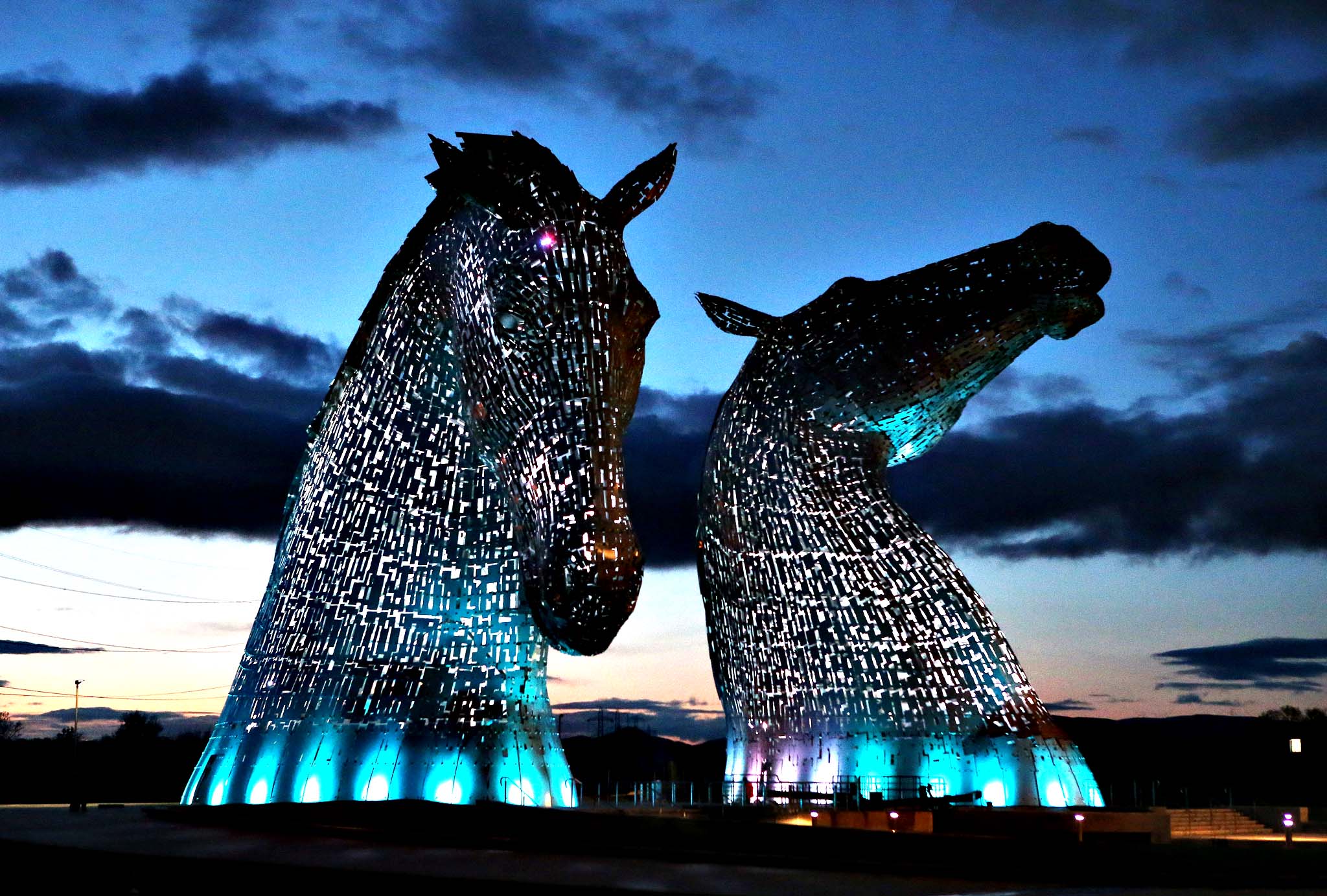
edit on 28/5/14 by Ramcheck because: (no reason given)
a reply to: Ramcheck
I love those sculptures, they're just breath-taking. Yes, they have the same shape - I hadn't seen that until now. I'm thinking that our 'bowed doghead' is a descendant of his Babylonian counterpart and I want to find a more contemporaneous example. I think the 'tuning fork' could possibly be the pronged fork, although I'm less certain of that.
I love those sculptures, they're just breath-taking. Yes, they have the same shape - I hadn't seen that until now. I'm thinking that our 'bowed doghead' is a descendant of his Babylonian counterpart and I want to find a more contemporaneous example. I think the 'tuning fork' could possibly be the pronged fork, although I'm less certain of that.
new topics
-
Democrats send letter to Biden urging him to ratify Equal Rights Amendment
US Political Madness: 3 hours ago
top topics
-
Reprehensible Behavior
US Political Madness: 15 hours ago, 11 flags -
This is adorable you guys!
General Chit Chat: 15 hours ago, 9 flags -
Defending the need for adherence to Old Testament commandments under the new covenant of Christ
Conspiracies in Religions: 16 hours ago, 5 flags -
Democrats send letter to Biden urging him to ratify Equal Rights Amendment
US Political Madness: 3 hours ago, 2 flags
active topics
-
Defending the need for adherence to Old Testament commandments under the new covenant of Christ
Conspiracies in Religions • 27 • : FlyersFan -
Those Fake Death Numbers From Hamas Out Of Gaza
Middle East Issues • 193 • : FlyersFan -
Rant. I am sick of people saying the police are revenue raising.
Rant • 13 • : PorkChop96 -
Only two Navy destroyers currently operational as fleet size hits record low
Military Projects • 23 • : Bluntone22 -
Light from Space Might Be Travelling Instantaneously
Space Exploration • 28 • : Lazy88 -
More Bad News for Labour and Rachel Reeves Stole Christmas from Working Families
Regional Politics • 9 • : covent -
Democrats send letter to Biden urging him to ratify Equal Rights Amendment
US Political Madness • 2 • : VariedcodeSole -
Post A Funny (T&C Friendly) Pic Part IV: The LOL awakens!
General Chit Chat • 7914 • : Cymru -
George Stephanopoulos and ABC agree to pay $15 million to settle Trump defamation suit
Mainstream News • 25 • : Echo007 -
-@TH3WH17ERABB17- -Q- ---TIME TO SHOW THE WORLD--- -Part- --44--
Dissecting Disinformation • 3713 • : 777Vader

